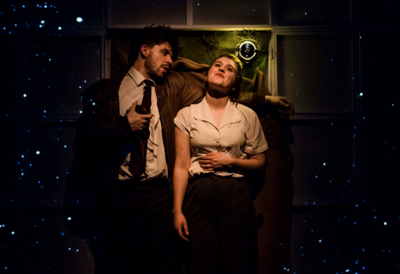
Idle Motion’s Shooting with Light is a surprising and emotionally demanding piece. It is a beautiful, tragic and warming tale of Gerda Taro, arguably the first female photographer to cover the front line of a war; and to die whilst doing so.

The tale tells two stories; that of Robert Capa and Taro’s ascent to success during the Spanish civil war and that of Capa’s stubborn brother to find a red suitcase of Robert’s missing photographs, many years after Capa and Taro’s death. The two separate tales, at first, are a little confusing but as the story progresses they become intertwined and with the help of a few vignettes the stories become clear and inseparable.
The stage is simple, just a plain white bookcase style background which possesses many doors and upon which images are projected. The first image is that of the red suitcase open, containing the rolls of film whereby the actors remove some of the films, carefully keeping the projector image on the boxes. Taro’s photographs are frequently displayed on the background charting her career from first learning how to use a camera in the bars of Paris to the war torn atrocities that eventually ended her life. In fact the best and most moving scene in this play is when the actors take to re-enacting Taro taking pictures whilst the pictures are shown behind them amidst the clamour of bombs and explosions.
The costumes are much understated and by that, one supposes, are unimportant to the overall message of the play. It seems that Idle Motion wish to strip the tale down to the story alone, throwing away all aspects of glamour and beauty to confront the audience with the harsh reality of war. At first it is difficult to draw oneself into the play as the over stylised and kabuki-esque movement seems to be gratuitous, slightly drama school and is possibly art for art’s sake – which does seem to take something away from this powerful performance. That aside, or once you can ignore it, the acting is encapsulating.
Capa and Taro bounce off each other with alacrity and their differing opinion on why they are war photographers is brilliantly encapsulated with Taro wanting to expose the horror of war and Capo wanting success and its trappings. Taro takes it personally and cannot untwine herself from the pain of the dead, wanting the world to know and sacrificing herself to tell the story whilst Capo can and knows that he must for his own sanity.
History has belonged to men for many years and their accomplishments have frequently overshadowed the talented women that have risen to the top and have, frankly, sometimes done a better job; Rosalind Franklin, Mary Ann Evans and Mary Anning to name but a few. It is amazing to see a show that remembers forgotten women and brings to the forefront the recognition that they have so often been denied.
By Mark Speed

Leave a Reply